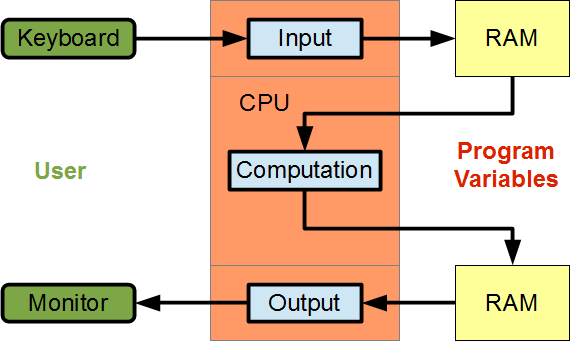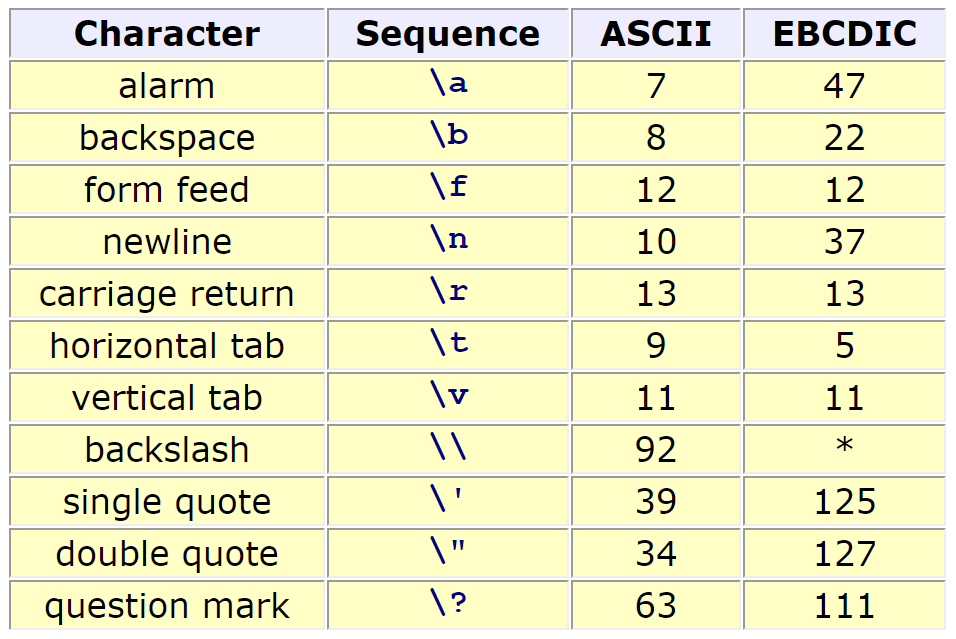A Simple Calculation
Learning Outcomes
- Create a computer program to solve a basic programming task
Introduction
Application programs receive input from the user, convert that input into output and display the output to the user. The user enters the input through a keyboard or similar device and receives converted output through a monitor or similar device. Program instructions store the input data in RAM, retrieve that input data from RAM, convert it using the ALU and FPA in the CPU and store the result in RAM as illustrated in the figure below.

A program that directs these operations consists of both program variables and program instructions that operate on data stored in those variables.
This chapter describes how to write an interactive program for calculating the area of a circle. The chapter covers the syntax for defining a program constant, accepting the radius from the user, calculating the area, storing the result in a variable and displaying a copy of that result to the user.
Constant Values
Constant values in a program can be numbers, characters, or string literals. Each constant is of a specific type. We define the type of a constant, like the type of a variable, when we declare the constant.
Numeric Constants
We specify the type of a numeric constants by a suffix, if any, on the value itself and possibly a decimal point.

To define a numeric constant in hexadecimal representation, we prefix the value with 0x.
const int x = 0x5C; // same as const int x = 92;
Example
To define the constant pi (π) to 5 significant digits, we select the float type and write
int main(void)
{
const float pi = 3.14159f; // pi is a constant float
// ... completed below
return 0;
}
The const keyword qualifies the value stored in the 'variable' pi as unmodifiable.
Character Constants
All character constants are of char type. The ways of defining a character constant include:
- the digit or letter enclosed in single quotes - for example
'A' - the decimal value from the collating sequence - for example
65for'A'(ASCII) - the hexadecimal value from the collating sequence - for example
0x41for'A'(ASCII)
The single-quotes form is the preferred form, since it is independent of the collating sequence of the execution environment.
Escape Sequences
Character constants include special actions and symbols. We define special actions and symbols by escape sequences. The backslash (\) before each symbol identifies the symbol as part of an escape sequence:

In the IBM reference card, System /370 Architecture Reference Summary, the \ does not have an EBCDIC code. Its value may vary from machine to machine.
Escape sequences are relatively independent of the execution environment. Their decimal values however vary with the collating sequence of the execution environment and should be avoided.
String Literals
A string literal is a sequence of characters enclosed within a pair of double quotes. For example,
"This is C\n"
The \n character constant adds a new line to the end of the string.
Simple Input
The scanf(...) instruction accepts data from the user (that is, the standard input device) and stores that data in memory at the address of the specified program variable. The instruction takes the form:
scanf(format, address);
This statement calls the scanf() procedure, which performs the input operation. We say that format and address are the arguments in our call to scanf().
Format
format is a string literal that describes how to convert the text entered by the user into data stored in memory. format contains the conversion specifier for translating the input characters. Conversion specifiers begin with a % symbol and identify the type of the destination variable. The most common specifiers are listed below.

A more complete table is listed in the chapter entitled Input and Output.
Address
address contains the address of the destination variable. We use the prefix & to refer to the 'address of' of a variable.
Example (continued)
To accept the radius of the circle, we write
#include <stdio.h> // for printf, scanf
int main(void)
{
const float pi = 3.14159f; // pi is a constant float
float radius; // radius is a float
printf("Enter radius : "); // prompt user for radius input
scanf("%f", &radius); // accept radius value from user
// ... completed below
return 0;
}
The argument in the call to scanf() is the address of radius, not the value of radius.
Coding the value radius as the argument is likely to generate a run-time error
scanf("%f", radius); // ERROR possibly SEGMENTATION FAULT
Missing & in the call to scanf() is a common mistake for beginners and does not necessarily produce a compiler error or warning. Some compilers accept options (such as -W) to produce warnings, which may identify such errors.
Computation
We know that the area of a circle is given by the formula:
A = π r2
To store the area in memory involves 4 program instructions:
- define a variable to hold the area (a declaration)
- square the radius (an expression)
- multiply the square by π (another expression)
- assign the result to the defined variable (another expression)
Multiplication
The multiplication operation takes the form:
operand * operand
operand is a placeholder for the variable or constant being multiplied. * denotes the 'multiply by' operation. The value of this expression is equal to the result of the multiplication.
Assignment
The assignment operation stores the value of an expression in the memory location of the destination variable. Assignment takes the form:
destination = expression
destination is a placeholder for the destination variable. expression refers to the value to be assigned to the destination variable. = denotes the 'is assigned from' operation. We call = the assignment operator.
Assignment is a unidirectional operation. destination must be a variable; that is, it must have a location in memory.
C compilers reject statements such as:
4 = age; // *** ERROR cannot set 4 to the value in age ***
Example (continued)
Adding the statements to store the area in memory yields:
#include <stdio.h> // for printf, scanf
int main(void)
{
const float pi = 3.14159f; // pi is a constant float
float radius; // radius is a float
float area; // area is a float
printf("Enter radius : "); // prompt user for radius input
scanf("%f", &radius); // accept radius value from user
area = pi * radius * radius; // calculate area from radius
// ... completed below
return 0;
}
Since the C language does not define an exponentiation operator, we need to calculate the square of the radius explicitly. Later, we will learn the pow procedure to perform exponentiation.
Simple Output
The printf(...) instruction reports the value of a variable or expression to the user (that is, copies the value to the standard output device). The instruction takes the form:
printf(format, expression);
This statement calls the printf() procedure, which performs the operation. We say that format and expression are arguments in our call to printf().
Format
format is a string literal describing how to convert data stored in memory into text readable by the user. format contains the conversion specifier and any characters to be output directly. The conversion specifier begins with a % symbol and identifies the type of the source variable. The most common specifiers are listed below.

A more complete table is listed in the chapter entitled Input and Output.
The default number of decimal places displayed by %f and %lf is 6. To display two decimal places, we write %.2f or %.2lf.
Expression
expression is a placeholder for the source variable. The printf() procedure copies the variable and converts it into the output text.
Example (completed)
The complete program for calculating the area of a circle is:
// Area of a Circle
// area.c
#include <stdio.h> // for printf, scanf
int main(void)
{
const float pi = 3.14159f; // pi is a constant float
float radius; // radius is a float
float area; // area is a float
printf("Enter radius : "); // prompt user for radius input
scanf("%f", &radius); // accept radius value from user
area = pi * radius * radius; // calculate area from radius
printf("Area = %f\n", area); // copy area to standard output
return 0;
}
The input and output while executing this program is:
Enter radius : 1
Area = 3.141593
C rounds floating-point output to 6 decimal places by default.